Amit Shah’s Strategic Masterstroke Leads BJP to a Dominant Victory in Bihar
- MGMMTeam

- 1 day ago
- 3 min read
The 2025 Bihar Assembly elections reshaped the state’s political landscape, placing the Bharatiya Janata Party (BJP) at the centre of power for the first time. The National Democratic Alliance (NDA) secured an overwhelming majority, winning 202 of 243 seats, while the BJP emerged as the single-largest party. This dramatic transformation did not happen by chance. It was the result of a precise, layered, and deeply coordinated strategy led by Union Home Minister Amit Shah. His approach combined grassroots mobilisation, disciplined alliance management, and a narrative that placed development and performance at the forefront of the campaign.

Alliance Management and Conflict Resolution
One of the foundational pillars of Shah’s strategy was the careful management of the NDA alliance. Instead of the BJP acting as a secondary partner—as in earlier coalitions—this election saw a near-equal seat-sharing arrangement with JD(U). This shift required delicate negotiations and an understanding of Bihar’s political sensitivities. Amit Shah personally intervened to prevent internal revolts, convincing nearly a hundred potential rebels to fall in line. His extended stay in Bihar, engaging directly with candidates, local leaders, and organisational workers, ensured unity within the alliance. This cohesion prevented vote-splitting and strengthened the NDA’s ability to present a united front against the opposition.
Ground-Level Campaign: Energy, Reach and Precision
Shah’s strategy travelled beyond boardrooms and meeting halls. It was visible in the intensity of the campaign that swept across Bihar. He chaired district-level strategy meetings, addressed a large number of rallies, and spent weeks mobilising the BJP’s cadre. The campaign paid particular attention to youth and women, recognising them as powerful influencers in the modern Bihar electorate. Strengthening booth-level teams and deepening the party’s presence in regions traditionally dominated by other political groups enabled the BJP to reach voters who had not been part of its base earlier. This meticulous ground strategy transformed enthusiasm into actual votes, creating a strong swing in the NDA’s favour.
Narrative Building: From Identity Politics to Performance
Amit Shah’s messaging emphasised a shift from caste-driven politics to performance-oriented governance. His speeches consistently highlighted stability, law and order, industrial opportunities, and development-driven politics. By contrasting this vision with Bihar’s earlier periods of instability—often referred to as “jungle raj”—he positioned the NDA as the only credible force capable of delivering economic transformation. Promises such as EV manufacturing units, pharmaceutical parks, and industrial corridors were not just rhetoric; they represented a long-term roadmap for Bihar’s economic revival. This narrative successfully connected with an electorate eager for growth and modernisation.
Weak Opposition and Strong Timing
The success of the NDA was also strengthened by the disorganised opposition, which failed to offer a unified strategy, coherent messaging, or strong leadership. Delayed seat-sharing decisions and internal disagreements weakened their campaign before it even fully began. In contrast, the BJP launched its preparations early, controlled the narrative from the start, and continued to stay ahead of the opposition throughout the campaign period. This strategic timing allowed the NDA to dominate public perception and secure voter trust well before poll day.
The MGMM Outlook
The Bihar Assembly election results illustrate how the state’s political landscape shifted decisively in favour of the NDA, powered largely by Amit Shah’s calculated and sustained strategy. From our viewpoint, the BJP’s rise as the central force in Bihar was not accidental but the outcome of disciplined alliance handling, ground-level mobilisation, and a clear development-first narrative. Shah’s long presence in Bihar, his success in negotiating with nearly a hundred potential rebels, and the transformation of the BJP from a junior partner to a leading force reflect a deep understanding of Bihar’s political complexities. His emphasis on organisational strength, youth and women outreach, and meticulous booth-level preparation ensured that the party’s message travelled to voters who were previously untouched by its influence. This shift from caste-centric politics to performance and governance-oriented discourse resonated strongly with an electorate seeking stability and growth.
The NDA’s victory was also made easier by the opposition’s lack of unity, delayed preparations, and absence of a compelling counter-narrative. While the opposition remained confused, Amit Shah controlled the narrative early—projecting industrialisation, law and order, and long-term development as the core agenda for Bihar. This strategic timing enabled the NDA to build trust and shape voter perception well before the campaign peak. The mandate clearly shows Bihar’s confidence in a new political direction, one that prioritises economic opportunities and strong leadership. Though the real challenge now lies in converting this massive political victory into visible development, the election has undoubtedly marked a turning point in Bihar’s political story, reaffirming Amit Shah’s influence on national electoral strategy.
(Sources: Times of India, News18, Hindustan Times)




Comments